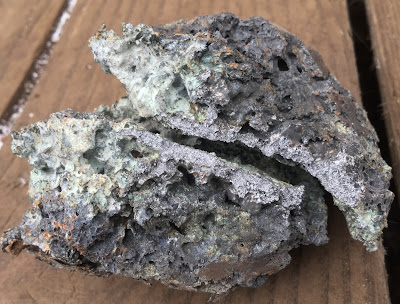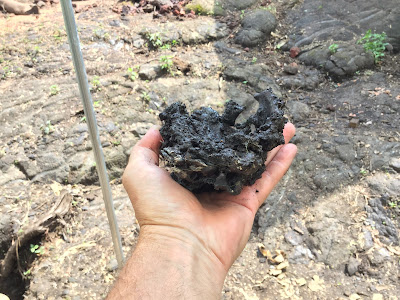This day has been all about playing with fire. In keeping with that theme, as soon as the previous bloom was spark checked for approximate carbon content, it was popped back into the furnace. Actually, all of the blooms that I had made were added together to see if this Oroshigane melting hearth could handle the larger volume of steel.
The prior bloom looked to my eye as if the air blast was a bit strong, so for the start of this melt, I separated the air feed pipe a couple of inches to take things down a notch.
One other notable difference for this melt is that the first two melts of the day had used up the amount of charcoal that I had sized and screened (roughly ½-1”, no fines). For this melt I was throwing chunks of charcoal in bucket, crushing them carelessly with a hammer, and adding the entire mess into the furnace, fines and all. The third and last melt of the day ran longer than the first two, mostly due to the reduced air pressure and volume. With less air, the charcoal seemed to be filling up the chimney column more completely and felt like the fan was having a hard time pushing air through the increased quantity of fines. I let things run for about 30 minutes to get the blooms back up to melting temperature, then reconnected the air supply pipe.
The flame tending to shift from red to yellow is more dramatic in picture than in real life, but does seem to correspond to the melting state of the iron inside the furnace.
Well…….the higher air pressure had no problem clearing the fines, that's for sure, haha!
My favorite!
The huge bursts of sparks only last for a few minutes after each charge of charcoal has been added, but add greatly to the overall excitement! After the fireworks have abated, the flame looks a bit less dramatic.
If you stare at the flames too long though, they will sometimes stare back. Ellie says this flame is full of fire demons!
I ran the melt for about 30 more minutes (roughly 1hr total), then let the charcoal burn down to the tuyere before pulling the bloom. This one I like, bloom and picture both!
The camera can be a valuable tool in discerning what is going on during these high heat processes. I think that it shows a better differentiation that I can see by eye, maybe some increased IR ability, I don't know. The higher density of the iron/steel holds the heat much longer than the less dense slag. As with the other blooms, the mass is cup shaped, dramatically so. A small amount of slag would ideally be sitting on top of the developing steel bloom, but in this case is getting blasted off the top and onto the far wall of the furnace.
I quench the bloom and pick out the small fragments of entrapped charcoal bits before finally giving it a quick spritz of phosphoric acid to dissolve the black oxides remaining on the surface. The original air blast direction is away from the viewer, the small slag mass being the furthest away.
The bottom of the cup shaped bloom is a fascinating construct of small blobs and ribbons of iron. The tiny ribbons are bright, shiny and very flexible. You can bend then back and forth repeatedly without them breaking and they spark test as very low carbon iron.
They are also razor sharp, something that I didn't realize until the next day. “How in the hell did I get all these cuts on my hand!?”
The side view of the bloom opposite the tuyere seems to show a gradient of steel, iron at the bottom shifting to cast iron at the top.
This bloom would've been great to keep as is or to consolidate into a tighter mass, but instead of that, I smash it cold into fragments, to check out the grain structure of the iron/steel. I can make more, right?
The mass as a whole is very tough, odd considering that the steel grain structure should be huge, given the high and prolonged temperatures, but this thin section broke nicely.
Mostly rather nice and relatively small grain steel with a tiny bit of iron showing the characteristic stranding we see in wrought iron. The darker gray areas outside the break spark as cast iron, with a very few short red sparks.
The higher heat of this final melt has put the end on a long afternoon of steel production. It isn't too clear in this photo, but the furnace wall has eroded back over 30 mm and the clay/charcoal tuyere is essentially gone. Large vitrified sections of the wall surrounding the highest heat areas have shattered and fallen away, presumably to end up as slag that was attached to the bloom.
First some furnace repairs, then more fun.






























